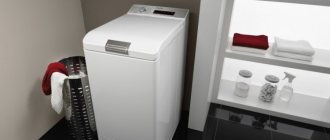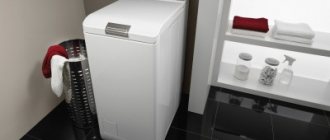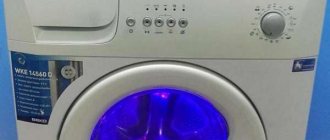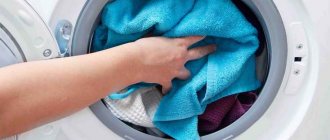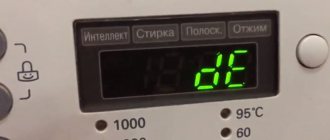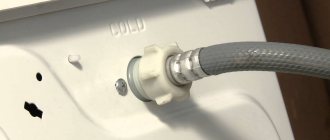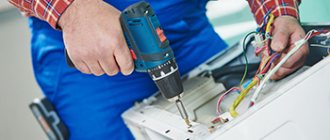There are two types of automatic washing machines based on the type of loading: front-loading or vertical loading. Models of each of these two varieties have advantages, disadvantages, an original set of characteristics and design features. They are united by common operating principles and a standard set of design components.
In this material, we will consider the basics of operation, design features, advantages and disadvantages of vertical washing machines, and the nuances of operation.
Device
Vertical washing machines have the following components required for operation:
tank is made of stainless steel or high-strength plastics. There are options for collapsible tanks, consisting of two parts connected by bolts. These tanks are subject to further maintenance and repair. There are also non-removable tanks that cannot be repaired.
The drum is a stainless steel cylinder. The laundry is immersed in it. A cross with a shaft is attached to the rear part. The inside of the drum is equipped with ribs that mix the laundry.
A counterweight is a plastic or concrete block that compensates for the balance of the tank during operation.
Electrical engine. There are different types of motors used for washing machines that rotate the drum. They are attached to the back of the device or to the bottom of the tank.
Drive belt - transfers torque from the engine to the drum. Belts are made of rubber, nylon or polyurethane.
Drum pulley , made of aluminum alloys, is a wheel fixed with a screw on the drum shaft. Serves to transmit movement from the drive belt. The diameter of the pulley determines the maximum speed during spinning.
The control unit is necessary to control the actions of the electrical components of the device. The processor contains programs that control washing. A control panel is connected to it, providing a choice of any of the available functions. The panel sends requests to the control unit and combines with it into one system.
A heating element. Thermoelectric heaters heat water to programmed temperatures by converting electrical energy into heat. They are also used during the drying process.
In addition to the listed elements, washing machines also contain in their design: shock absorbers and springs to compensate for vibrations, and a relay to regulate the water level.
The water injection and pumping system consists of a drain pump to which a hose and rubber pipes are connected. The fill valve regulates the amount of water entering the tank. The hatch blocking device prevents the device from starting with the door open.
Each machine has a detergent dispenser: a plastic box with a connected pipe.
Main nodes
Let's start with the general structure of the Ardo family automatic washing machine. The vast majority of the structural elements of these washing machines are no different from the structural elements of other washing machines.
For your information! Modern models of Ardo washing machines have the technical ability to connect to hot water supply, so instead of an electric valve they have a block of electric valves.
Other elements
We talked about the main components of the Ardo washing machine, now we will give a list of additional elements. We note right away that the composition, appearance and functional purpose of the elements may differ depending on the specific model of Ardo brand washing machines. So, what elements are we talking about?
Older Ardo washing machines have springs installed on the tank that dampen vibration; new models have hydraulic struts instead of springs.
In addition to all the main and additional elements of the Ardo washing machine, which ensure its operation. It would be nice to say a few words about the body of the washing machine. The housing also ensures the operation of the washing machine, since its task is to protect the mechanism from any external influences. Part of the body of the Ardo washing machine is made of plastic, and part of metal. The body consists of the following elements:
How does it work
The operation of the machine after loading the laundry and determining the desired program consists of several stages.
- When the selected program starts, the washing process begins. Water is poured into the apparatus in a certain volume. Detergents mixed with water come out of the dispenser. This is the soaking stage.
- Starting the electric heater. Washing stage programmed by the user at startup.
- Draining the water and then spinning it. Filling an empty tank with water. Rinsing.
- Drain water and quickly spin. Repeat the stage 2-3 times.
- Final spin. Pumping out water. Sending a signal to the control unit. Unlocking the hatch.
Where does the hot water come from?
As with front-mounted automatic machines, on vertical units a tubular electric heater – heating element – is responsible for heating. Once the user selects a mode and adjusts the temperature, the electronic board accepts the parameters and starts the heater. The part receives the signal, and upon completion of filling, its “spiral”, brought into the tank, begins to heat up.
To avoid overheating of the heating element, do not run three high-temperature cycles in a row!
The degree of heating is monitored by a thermistor - a temperature sensor. It looks like a metal tube and is located in the heating element itself. When the set degrees are reached, the device signals the module, which turns off the heater.
Design
The main design feature of vertical washing machines, as is clear from the name, is the vertical location of the hatch for loading laundry. These devices do not have a transparent loading hatch in the front.
There are models where a special mechanism is used to regulate the drum to stop it after the end of the wash. These devices are called drum parking systems.
The second difference between vertical models is two symmetrically located drums and shafts on both sides, on which it rotates. Front-facing samples have one shaft rotating the drum on the rear side, since laundry is loaded into it from the front side.
Laboratory studies of companies producing both types of washing devices show some advantage in reliability and service life of vertical washing machines due to two shafts instead of one for front-facing models.
The control panel for vertical samples is standardly located at the rear of the top cover.
Standard dimensions of top-loading devices: height – 85–90 cm, depth – 60 cm, width – 40–45 cm.
The amount of laundry that can be loaded into a top-loading machine is determined by standard rules common to all types of devices from any manufacturer. There are minimum and maximum loads, measured in kilograms.
The minimum load of 1 kg is determined based on the need for uniform distribution of laundry throughout the drum at high spin speeds to level out unwanted excess vibrations. The maximum load – 10 kg and above is limited by the dimensions of the device.
Typical household washing machines have a load capacity of 5–7 kg.
Criterias of choice
When choosing, you need to carefully study those points that are specific to this type of machine:
- dimensions - allow you to build the machine into a small niche - from 45 to 50 cm. There are many “narrow” front models in stores, but here you should take into account the need to open the door;
- drum volume - the selection of the model must be carried out based on the composition of the family. Manufacturers offer models with drum volumes from 4 to 15 kg. For example, for a family of 5 people, a unit with a capacity of 7 kg will be sufficient;
- Operating principle: drum and activator. In the first, washing occurs due to the rotation of the drum, in the second, the water is rotated by the blades of a special nozzle located under the tank. The latter are considered more economical, but less functional;
- type of control - electronic, mechanical and combined. The electronic type of control frees the user from some manipulations. It is enough to press one button, the mode with the set parameters will be launched. It's comfortable. Especially if you are in doubt about how to wash this or that item;
- number of programs. Practice shows that most users use only two or three special programs;
- spin class and electricity consumption. The higher these indicators, the more efficient and economical household appliances will work;
- protective functions - modern models must be equipped with automatic protection systems;
- automatic diagnostic system. If there is a breakdown, the system itself will display an error code on the display. This may be a letter designation. If there is no display, it may be the blinking of diodes on the panel in a certain combination.
Automatic diagnostic system
Functions
Vertical devices have full functionality identical to frontal models. The washing process in them is convenient and automated.
Among the functions requested by users:
- Control of foam formation. The device automatically drains water with excess foam and fills with new foam. The amount of foam is controlled before spinning to improve rinsing quality.
- Additional rinse. Before spinning, the washing machine performs an additional rinse to completely remove any remaining detergent.
- Half loading mode. The function saves water and energy consumption and reduces cycle time. In demand when washing small amounts of laundry.
- Additional soaking. Necessary when washing contaminated items. The laundry is rinsed additionally before starting the main program. Detergents act by getting into an already wet item.
- Leak protection. Required to control leaks in the machine and inlet hose. When the system is activated, the moisture suction pump automatically turns on.
- Manual, delicate and quick wash modes. Special modes designed for washing certain categories of linen and clothing. They have their own characteristics, both in terms of operating time and in the use of different volumes of water.
- Adjustable spin. The system allows you to change the spin speed, which helps in case of heavily damp laundry or strong shaking of the machine during high-speed spinning.
- Child protection. Blocks door opening and accidental pressing of buttons on the control panel.
- Start timer. Allows you to program the launch of a prepared device at the desired time. A convenient function if you have different tariffs (day, night) for electricity.
- Fault diagnosis. Washing machines with a display display information about faults in the form of standard codes.
- Turbo drying system. Provides drying of clothes with heated air.
Machine control center
Most modern washing machines have electronic controls. Unlike the “old” mechanics, everything here is performed and regulated by a module - a connecting unit consisting of sensors, conductors, tracks and microcircuits. The system works as follows:
- the user sets the cycle settings by pressing buttons or rotating the programmer on the dashboard;
- the control board records the selected parameters and issues a command to execute the program;
- the necessary system nodes are turned on;
- the wash starts.
It is the control module that starts the washing machine: it processes information from the dashboard and transmits commands “through the chain” to the destination. Turning on the equipment, drawing water, accelerating the engine, draining - all this is performed only after “permission” from the electronic unit using a variety of triacs, sensors and contacts. Afterwards, the board controls the progress of work, monitoring the signals and data coming from the nodes. In the event of a failure or deviation, the device detects the problem and urgently shuts down the cycle.
It is not recommended to test and solder the board at home - it should be checked and flashed by specialists!
If there is a failure in the electronics system, the machine stops working: it does not turn on, does not respond to user commands, or freezes. It is difficult to find the problem, since either a separate track or the entire control unit as a whole could fail. In any case, the board loses control over the washing machine and, for security reasons, does not allow startup.
An electronic module is an extremely complex part. It is quite difficult to figure out on your own how it works and functions, especially for people far from electrical engineering. It’s better not to take risks and if you suspect a board malfunction, immediately contact a service center.
Washing spin and energy efficiency classes
The washing class is determined by assessing the remaining contaminants after the experimental washing process. Testing takes place under standard conditions for all tested samples, and then comparison is made with the results of reference samples. Then each model is assigned its own class from A to G in order of deterioration in consumer properties. Most modern machines have wash class A.
The spin class is determined by the speed and efficiency of the spin process. To designate classes, the same Latin letters from A to G are used in order of decreasing spin quality. Spin efficiency depends on the amount of residual moisture in the laundry. 40% is the best indicator, 90% is the worst.
The choice of sample with the best spin class indicator is ambiguous. Not all fabrics can be wrung dry without risk of damage. A high spin class increases the cost of the machine. Not every consumer needs such high standards.
The standard spin class for most washing machines is C.
Energy efficiency class is an important characteristic, given the rate of increase in electricity tariffs. All models are assigned classes from A to G in order of decreasing efficiency. There are models with classes A+, A++, A+++.
The difference between them is determined by the minimum amount of energy consumed, but the price is significantly different. When choosing a washing device based on its energy efficiency class, it is worth weighing several factors: electricity tariffs, frequency of use.
Pros and cons of a top loading washing machine
Vertical washing machines have both advantages over front-facing models and lose to the latter in some aspects.
Advantages:
- Compact size. The laundry capacity in both types of devices is equal, and the dimensions of the vertical samples are more modest. When installed, they do not require additional space to open the hatch door. Narrow washing machines can be used in confined spaces without losing wash quality.
- You can look into the drum of a vertical machine when the washing process is running. This allows you to add additional items at any stage without draining the water.
- Ease of use. The vertical model is easy to load laundry into. To do this, you don’t need to constantly bend down and sit down.
- Child safety. The location of the control panel at the back of the top cover makes it difficult for children to access.
- Noise protection. Vertical models vibrate less during spinning and therefore produce less noise.
- Reliable design. Two bearings that hold the drum vertical reduce the possibility of failure due to overload.
Flaws:
- The cost of vertical models is higher (25–30%) than similar frontal models.
- Small assortment.
- It is impossible to integrate vertical machines into a kitchen set or other furniture structures.
- You cannot use the top cover of the device to place accessories on it.
Final comparison
It is possible to objectively evaluate different models only after their advantages and disadvantages have been studied. But in choosing the optimal option, you should not rely only on such parameters. Design features, functionality, and technical parameters should be taken into account.
So, let's summarize.
Advantages and disadvantages of frontal machines
This technique is much easier to choose. This is explained by the fact that the designs are more common, there are many options. Today, the market has a large number of devices that are distinguished by practicality and functionality. The main advantages include:
- reasonable cost of products,
- the ability to integrate the machine into furniture,
- optimal sizes.
Machines of this group can be located in rooms of various sizes. A huge number of models makes it possible to choose the appropriate parameters for any buyer.
The only drawback is the inability to add additional laundry during washing. But this is not critical, and such a minus does not affect the choice.
Advantages and disadvantages of vertical models
Cars with such loading are considered less in demand. Most consumers are not accustomed to such models; they are more accustomed to seeing machines with a side window in the bathroom. When choosing the type of loading element, the consumer prefers a more aesthetic appearance, which is not the case with vertical machines.
The main advantages of the washing machine are:
- small sizes. The cars are truly considered the most compact of all that exist,
- it is possible to load additional laundry during washing,
- the door open upward does not occupy the space surrounding the machine.
A top-loading washing machine has a high cost, which is explained by its practicality. The second drawback is the inability to build the machine under a countertop or sink.
It is believed that in models with vertical loading, the drive mechanism is less loaded, and accordingly, it will last longer. Bearing destruction occurs less frequently, and the machine is more resistant to centrifugal forces. The vertical has a slightly different arrangement of shock-absorbing elements and counterweights, which gives it greater stability. But the structural differences remain visible.
In addition, machines with a front hatch have a large number of working functions - drying, bubble washing, steam washing, etc. New models of the vertical group also have some functions, but most models do not have drying.
How to use
No matter how high the cost and quality of the purchased washing machine, its durability and wear resistance depend on proper operation. It is important to carefully study the instructions for using the device and take into account all notes regarding installation and further use of the device.
Installation requires a level and solid underlying surface. It is important to make sure that the water supply lines are working properly and that the water pressure in the pipes corresponds to normal values. A reliable connection of the drain hose is also necessary.
When preparing laundry, sorting by type and color will help. Remove hard objects from pockets that could cause damage to the machine. It is better not to wash too dirty or shabby bed linen or work clothes.
When washing in modern automatic devices, it is advisable to use specially designed detergents. Do not fill the machine dispenser with excess detergent.
It is important to control whether the washing temperature corresponds to the specified mode. After completing the cycle, be sure to close the tap and disconnect from the power supply. Between several washes in a row, a break of 1–2 hours is useful.
Main nodes
Let's start with the general structure of the Ardo family automatic washing machine. The vast majority of the structural elements of these washing machines are no different from the structural elements of other washing machines.
For your information! Modern models of Ardo washing machines have the technical ability to connect to hot water supply, so instead of an electric valve they have a block of electric valves.
Other elements
We talked about the main components of the Ardo washing machine, now we will give a list of additional elements. We note right away that the composition, appearance and functional purpose of the elements may differ depending on the specific model of Ardo brand washing machines. So, what elements are we talking about?
Older Ardo washing machines have springs installed on the tank that dampen vibration; new models have hydraulic struts instead of springs.
In addition to all the main and additional elements of the Ardo washing machine, which ensure its operation. It would be nice to say a few words about the body of the washing machine. The housing also ensures the operation of the washing machine, since its task is to protect the mechanism from any external influences. Part of the body of the Ardo washing machine is made of plastic, and part of metal. The body consists of the following elements:
Malfunctions and repairs
Vertical washing machines, like front-facing ones, have a similar list of standard breakdowns. They also have typical faults unique to them.
General faults:
Limited bearing service life . Sooner or later, the bearings on any device will have to be changed. Repairing vertical washing machines is considered more labor-intensive, and they also have twice as many bearings as front-facing models.
The drum of the machine may not spin. You can inspect the drum yourself by rotating it in different directions. A foreign object caught in it prevents free rotation. The second option is a broken or damaged drive belt.
If water does not drain from the device. Most likely the drain hose is pinched. If the hose is in order, you can check the drain pump filter: foreign objects may have gotten into it. Poor drainage also occurs when plastic sewer pipes become clogged.
Increased washing time , which differs from that set by the program. Electric heater failure.
Water leaking from the device . If the car was purchased recently, then we are talking about a manufacturing defect or poor build quality. A guaranteed exchange will come to the rescue. Equipment that has been in use for a long time may have cracks and ruptures in the drain hose and water supply hose. I'm going to have to buy a new hose.
If the device does not heat water. The electric heater is damaged.
Typical faults:
Arbitrary opening of the drum flaps . It happens when the unit becomes unbalanced due to prolonged use. The flaps touch the electric heater and, possibly, jamming of the drum with rupture of the drive belt and damage to the drum itself. In this case, expensive repairs are guaranteed.
Corrosion of the top cover of the device . The reason is the peculiarity of supplying water to the drum through the lid itself. Eliminating the cause is replacing the cover.
A few convenience issues
This point also needs to be given attention. Which machine is still more convenient to use? To answer such a question, subjective factors must be taken into account. Often a person simply likes vertical loading, since he is more accustomed to it, and there is no explanation for this. The same can be said about cars with a front hatch. You should not focus on subjective aspects; it is better to immediately consider the objective reasons that make this or that group of washing machines convenient:
- For vertical group cars, the hatch is located on top. When loading laundry you will not have to bend over, and this is very convenient for users suffering from radiculitis,
- For washing machines with a front hatch, the top panel is free. Many people place cans, bottles, bags of powders and other things on its surface, finding a certain convenience in this. But the buttons and elements of the touch group are located on the front panel. On the left there is a tray with three compartments, where you can pour washing powder, liquid soap and fabric softener,
- the front model can be installed under the countertop, but the vertical model will require free space on top,
- In a front group machine, the tray for detergent compositions can be easily removed, and it is much more convenient to use. Owners of a vertical unit claim that their model is very convenient in this sense, but their opinion remains in the overwhelming minority.
